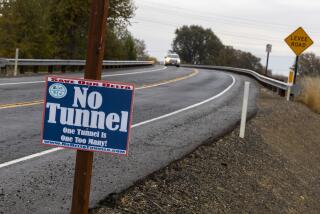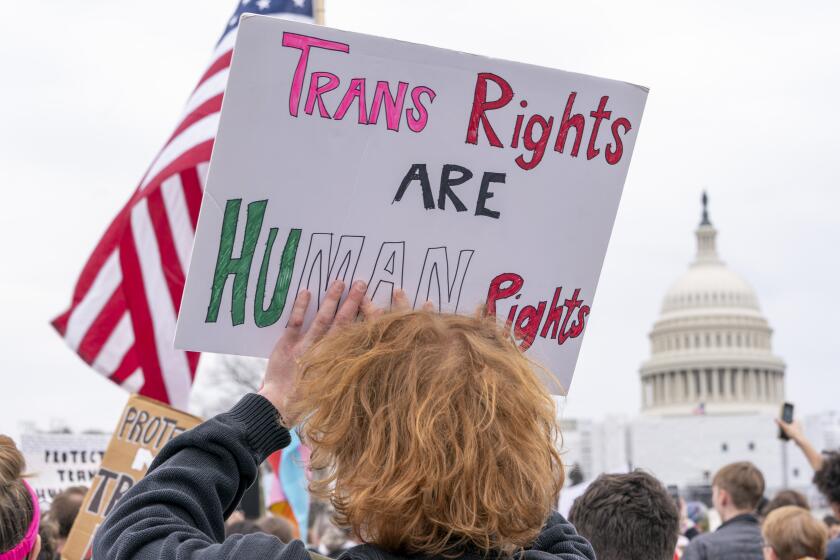Shaky rationale behind Brown tunnel plan
- Share via
SACRAMENTO — Maybe I’ve watched the movie “Chinatown” too many times, but a major justification for digging Gov. Jerry Brown’s massive water tunnels just seems suspicious.
Brown’s not creating a drought by dumping water in the ocean and poisoning wells, as Noah Cross (John Huston) does in the classic film inspired by Los Angeles’ draining of the Owens Valley.
Developer Cross was selling L.A. voters on the need for a water bond to finance an aqueduct and reservoir.
Brown and the water buffaloes — government bureaucrats, corporate farmers, urban expansionists — are peddling their own rationale for a $25-billion re-plumbing of the Sacramento-San Joaquin River Delta.
A catastrophic earthquake could topple current levees, flood the delta and cut off much of the fresh water supply to Central and Southern California for months, even years, tunnel promoters warn.
Never mind that there’s little historical evidence to support the potential for such a calamity.
“If they have to resort to a lie to justify [the project], then the actual justification must be pretty darn weak,” says Bob Pyke, a Bay Area consulting engineer who specializes in earthquake protection and is an outspoken critic of Brown’s plan.
“Lie” is a bit strong. Let’s just call it a stretch, an attention-getting talking point also used in the delta re-plumbing pitch by previous administrations. Nothing stirs Californians like earthquake chatter.
I bought into the earthquake argument for years until it finally dawned on me that I’ve lived in Sacramento for several decades and never felt — or heard of — a local serious shaker. Indeed, it’s one of the pluses in residing here.
Sure, back in 1989 when the Loma Prieta earthquake interrupted the World Series in San Francisco and collapsed an Oakland freeway and part of the Bay Bridge, we felt some rolling 100 miles away. That 6.9 temblor along the San Andreas Fault killed 63 people. But there was little damage in the state capital.
More relevant to this writing, no levees collapsed in the delta, between Sacramento and the Bay Area. In fact, they didn’t even suffer damage. “None at all,” Pyke says.
I called another expert, Gilbert Cosio, an engineer who has been patching delta levees for 30 years and contracts with 27 maintenance districts. “There was a lot of shaking and we found a few hairline cracks,” Cosio says. “But we couldn’t verify that they were from the earthquake.”
There were a couple of East Bay earthquakes in the early 1980s and neither damaged delta levees, Pyke says.
The most famous Northern California quake devastated San Francisco in 1906. But it didn’t topple any delta levees either, he says. “And they were really crappy then.”
But some delta islands have subsided below sea level since that time, making them more vulnerable, state water officials contend.
Yes, they’ve sunk, Pyke and Cosio say. But the levees protecting them have been greatly improved. In the last 10 years, $300 million has been spent bolstering the embankments, and there’s still $200 million left from a 2006 voter-approved bond issue.
Another twin-tunnel opponent, University of the Pacific economist Jeff Michael, makes this observation: “If the risk of an earthquake is as high as the state says, the humane thing to do would be to act to save the lives of the [50,000] people living in the delta, not just protect the water supply for L.A. and San Joaquin Valley agriculture.”
That would require $2.5 billion more for levee-beefing, Cosio estimates.
The delta is California’s main water well, relied on by 24 million people for some or all of their drinking water and by farmers to irrigate 3 million acres.
But water deliveries have become unstable as courts have restricted flows to protect salmon and other endangered fish. The worst culprits are giant pumps in the southern delta that chomp up fish and reverse river flows, confusing migrating salmon.
Brown’s answer is to siphon Sacramento River water at the north end of the delta and send it through two 40-foot wide, 35-mile long tunnels directly to the southbound aqueducts. But that would reduce fresh water flowing through the delta, making the estuary more salty and some farming problematic.
Also, the 10-year construction would be a major disrupter of delta agriculture, recreation, migratory birds and human life.
The tunneling cost is pegged at $16 billion, paid by water agencies through higher customer fees. An additional $9 billion would be spent on ecological upgrades and footed by all taxpayers.
The state water department last week dropped a 34,000-page “draft” tunnel plan on the public. The document contends that “a major earthquake or storm pose the greatest dangers to the delta, potentially causing levee failures and flooding on as many as 20 islands at once and jeopardizing water supplies for two-thirds of the state.”
It cites the U.S. Geological Survey estimating a 63% chance of a 6.7 magnitude earthquake in the Bay Area before 2036.
OK, but that hasn’t seemed to bother the delta before.
“There may be some minor faults under the delta,” Pyke says. “But they wouldn’t produce very big earthquakes if they did erupt. And they wouldn’t affect levees in any significant way.”
Let’s be honest, the real threat is not quakes. It’s judges who restrict water pumping to protect fish. As they should.
Before spending $16 billion boring oversize tunnels and mucking up people’s lives, how about this? Try modern fish screens. Relocate the pumps so they don’t reverse river flows. Take the water after it flushes through the delta. Drill one much-shorter tunnel connecting to the aqueducts.
As in “Chinatown,” the delta needs a Jake Gittes (Jack Nicholson). Pyke seems to be auditioning.
More to Read
Sign up for Essential California
The most important California stories and recommendations in your inbox every morning.
You may occasionally receive promotional content from the Los Angeles Times.














